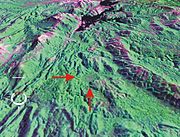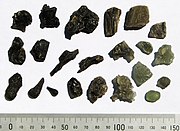
Darwin Crater

| Darwin Crater Tasmania | |
|---|---|
 | |
| Coordinates | 42°18′15″S 145°39′27″E / 42.30417°S 145.65750°E |
Darwin Crater is a suspected meteorite impact crater in Western Tasmania about 26 km (16 mi) south of Queenstown, just within the Franklin-Gordon Wild Rivers National Park. The crater is expressed as a rimless circular flat-floored depression, 1.2 km (0.75 mi) in diameter, within mountainous and heavily forested terrain. It is east of the West Coast Range and the former North Mount Lyell Railway formation.

Discovery and description
The crater was discovered by the geologist R. J. Ford in 1972, after a search for the source of Darwin glass,[1] an impact glass found over more than 400 square kilometres (150 sq mi) of southwestern Tasmania.[2] Geophysical investigations and drilling have shown that the crater is filled with up to 230 metres (750 ft) of breccia capped by Pleistocene lake sediments.[3][4] Although definitive proof of an impact origin of the crater is lacking, the impact hypothesis is strongly supported by the relationship of the glass to the crater, as well as the stratigraphy and deformation of the crater-filling material.[4]

If the crater is indeed the source of the glass, the age of Darwin Crater is 816,000 ± 7,000 years—the age of Darwin glass as determined by argon–argon dating method.[5]

Carbonaceous inclusions have been found for the first time in Darwin glass: these have been shown to be biomarkers which survived the Darwin impact and are representative of plant species in the local ecosystem—including cellulose, lignin, aliphatic biopolymer and protein remnants.[6]

Drilling
Various projects have drilled at the site. In 2007, Howard and Haines reported on their research.[4] In 2018, the sediments in the crater were drilled and investigated.[7]

Access
While there was a trail leading to the crater in the 1970s, accounts note that it is unmaintained, overgrown and boggy in places.[8][9]

Gallery
-
Oblique false-colour Landsat image of Darwin Crater (arrowed) draped over digital elevation model; screen capture from NASA World Wind
-
Assorted fragments of Darwin glass (scale in mm)
See also
References
- ^ Ford, R.J. (1972). "A possible impact crater associated with Darwin glass". Earth and Planetary Science Letters. 16 (2): 228–230. Bibcode:1972E&PSL..16..228F. doi:10.1016/0012-821X(72)90194-X.
- ^ Howard, K.T.; Haines, P.W. (2003). "Distribution And Abundance Of Darwin Impact Glass" (PDF). Third International Conference on Large Meteorite Impacts.
- ^ Fudali, R.F.; Ford, R.J. (1979). "Darwin glass and Darwin crater - A progress report". Meteoritics. 14 (3): 283–296. Bibcode:1979Metic..14..283F. doi:10.1111/j.1945-5100.1979.tb00504.x.
- ^ a b c Howard, K.T.; Haines, P.W. (2007). "The geology of Darwin Crater, western Tasmania, Australia". Earth and Planetary Science Letters. 260 (1–2): 328–339. Bibcode:2007E&PSL.260..328H. doi:10.1016/j.epsl.2007.06.007.
- ^ Lo, C.H.; Howard, K.T.; Chung, S.L.; Meffre, S. (2002). "Laser-fusion 40Ar/39Ar Ages of Darwin Impact Glass". Meteoritics & Planetary Science. 37 (11): 1555–1562. Bibcode:2002M&PS...37.1555L. doi:10.1111/j.1945-5100.2002.tb00810.x.
- ^ Howard, K.T.; Bailey, M.J.; et al. (2013). "Biomass preservation in impact melt ejecta". Nature Geoscience. 6 (12): 1018–1022. Bibcode:2013NatGe...6.1018H. doi:10.1038/NGEO1996.
- ^ Lise-Pronovost, Agathe; Fletcher, Michael-Shawn; Mallett, Tom; Mariani, Michela; Lewis, Richard; Gadd, Patricia S; Herries, Andy I. R; Blaauw, Maarten; Heijnis, Hendrik; Hodgson, Dominic A; Pedro, Joel B (2019), Scientific drilling of sediments at Darwin Crater, Tasmania, Copernicus Publications, retrieved 10 March 2023
- ^ Brattstorm (15 April 2009). "Darwin Crater". Archived from the original on 11 November 2016. Retrieved 14 June 2017.
- ^ Novak, Martin (26 November 2012). "Darwin Crater Trip Report". backpackertas.com.au. Archived from the original on 23 March 2020. Retrieved 15 June 2017.
External links
Further reading
Howard, Kieren Torres (2004). Origin of Darwin glass. University of Tasmania.

See what we do next...
OR
By submitting your email or phone number, you're giving mschf permission to send you email and/or recurring marketing texts. Data rates may apply. Text stop to cancel, help for help.
Success: You're subscribed now !





